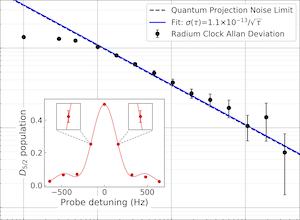Craig Holliman led a team, including collaborator Sam Brewer, to realize the first optical clock based on the radium ion. Radium is a famously unstable element, so it is a bit ironic that our group has made a high-stability clock using one of its optical transitions. But, looking more closely the radium ion has appealing features for a trapped ion clock. The wavelengths for working with trapped radium ions are very user-friendly: all of the necessary transitions could be addressed with low optical powers using integrated photonic sources. This makes the system promising for a compact and low-power optical clock. The ion’s high mass is good for addressing some of the leading issues with optical clocks. In the future when we begin working with radium-225 there will be built-in insensitivity to nefarious magnetic field noise through the isotope’s particular electronic structure. A radium ion clock could also be used to constrain the time variation of fundamental constants. The Letter describing this work was published today in Physical Review Letters, and is also available on the arXiv.
